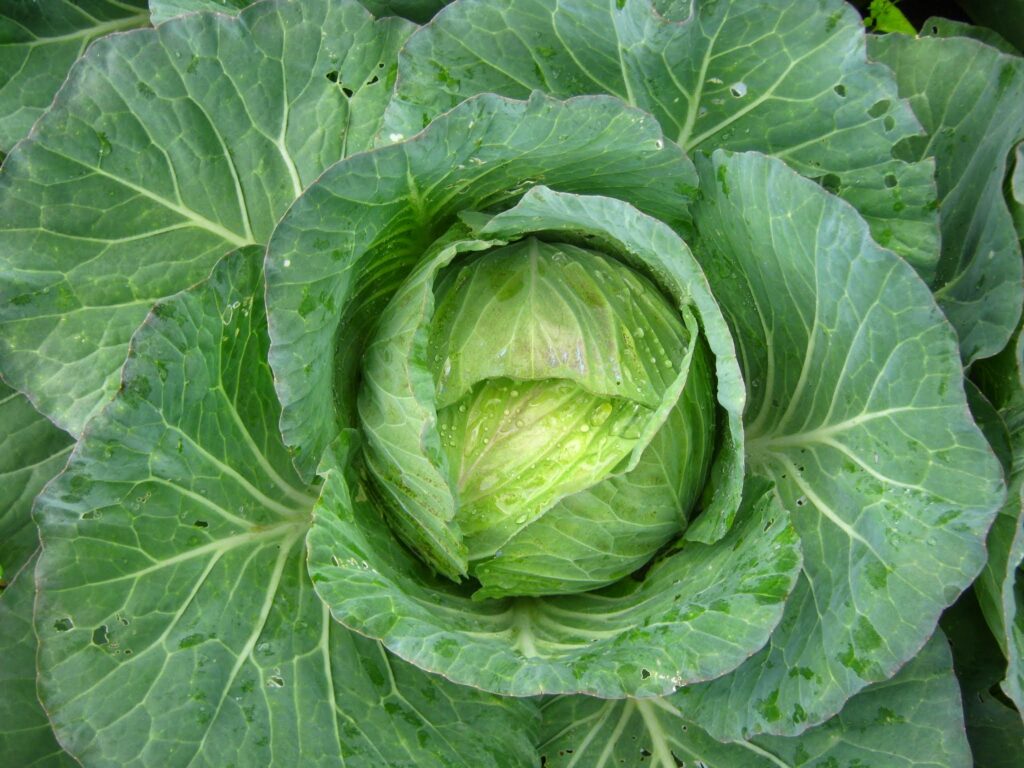Different varieties grow at different rates. However,
generally speaking, most cabbages are ready for harvest within 70 days of the date you transplanted the
seedlings. It’s okay to leave them a little longer before harvesting if you want the heads to grow larger.
Most varieties produce heads weighing from 1 to 3pounds (0.45 to 1.36 kg). You can harvest spring
cabbages young as loose greens, which will allow for repeated cuttings. Young, small cabbages tend to
be sweeter and tastier than older cabbages with bigger heads.
Cut the cabbage head at the base. Use a clean, sharp knife to cut off the cabbage
head as close to its base as possible. After cutting it, immediately move it to a shady spot or take it inside.
After harvesting, refrigerate your cabbages as soon as possible. Plastic wrap or a plastic bag will help
your cabbage heads retain moisture, so they’ll last longer. Properly stored cabbage will last at least 2
weeks in the refrigerator, and may last as long as 2 months.
If you’ve harvested more cabbage than you can consume within a few weeks, store it in a root cellar or
cool basement if you want to keep it fresh. Cabbage keeps well for 5 to 6 months if stored in a moist
place with a consistent temperature of between 32 and 40 °F (0 and 4 °C).
Cabbage is a biennial, which means that it blooms in the second year.
Choose plants that have the traits you want to carry over for the following year this may mean not eating
your best heads of cabbage, in order to use them for their seeds. Alternately, you can plant cabbage
specifically for harvesting seeds. Allow selected cabbage heads to mature.
If you want to get your own seed from your cabbages, choose open-pollinated varieties rather than F1
hybrids, so they’ll breed true. Cabbages cross easily, not only with other cabbages but with kale, kohlrabi,
cauliflower, broccoli, collards and Brussels sprouts, so you’ll need to protect your seed cabbages if other
plants of the same species are blooming within 1,000 feet.
Set poles upright around the cabbages about 4 feet high and connect the tops with wire or heavy cord.
When the seed stalks emerge in early summer but before they bloom, cover the framework with netting
that’s woven tightly enough that bees can’t get through. When the flowers open, raise the cover long
enough each morning to allow bees to enter and let them stay inside to pollinate the plants, then raise
the cover to release them. Repeat while the plants are blooming, then remove the covering while the
seeds mature. If no other plants that cross with cabbages are blooming at the same time within 1,000
feet, you can omit the protection and just let bees come and go to pollinate them naturally.
If your winters are mild, rarely getting more than a few degrees below freezing, cover the heads with
straw or other loose mulch to protect them from freezing. If your winters are severe, pull them up with
roots intact and store them in a root cellar or bury them under at least a foot of dirt and mulch, deeper in
the coldest climates. You want them to be kept cool but never frozen solid and damp enough so they
don’t dry out but not so damp that they mold.
Dig up or uncover the cabbage heads when the danger of hard freezing is past. Plant or transplant
them 1/12 to 2 feet apart, spaced in a square or grid rather than a row if you’ll need to protect them
from cross-pollination. Plant them deep so the heads are at ground level. Cut an “x” in the top of each
head, about an inch deep, to let the flowering stock emerge easily. Tie the seed stalks loosely to poles
to keep them from bending or breaking in strong wind or rain as the seeds mature. Wait several weeks
for the seeds to ripen.
Pick the seedpods when they first turn brown, before they burst open and spill their seeds. Some mature
before others, so pick them every few days. Lay them on a tray in the sun to finish drying. If you don’t
mind losing some, you can wait until the majority have turned brown, cut the whole seed stalk and lay it
on a tray or sheet to dry. For the most viable seed, let the pods mature as long as possible on the plant.
Put the pods in a cloth bag and lightly pound it or crush it to knock the seeds loose, then carefully pour
them out. Use a coarse sieve to separate them from larger debris or pour them from one container to
another in a light breeze to let the lighter pieces of broken pod blow away.
Keep the seeds in a dark, dry place until you want to plant them.
Cabbage seeds remain viable for up to 5 years.
Cabbage seeds are an excellent addition to micro green sprouting mixes.






